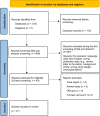A systematic review of the clinical evidence for an association between type I hypersensitivity and inner ear disorders
- PMID: 38595846
- PMCID: PMC11003305
- DOI: 10.3389/fneur.2024.1378276
A systematic review of the clinical evidence for an association between type I hypersensitivity and inner ear disorders
Abstract
Inner ear disorders have a variety of causes, and many factors can contribute to the exacerbation of cochlear and vestibular pathology. This systematic review aimed to analyze clinical data on the coexistence and potential causal interaction between allergic diseases and inner ear conditions. A search of PubMed and Web of Science identified 724 articles, of which 21 were selected for full-text analysis based on inclusion and exclusion criteria. The epidemiologic evidence found overwhelmingly supports an association between allergic disease and particular inner ear disorders represented by a high prevalence of allergic reactions in some patients with Ménière's disease (MD), idiopathic sudden sensorineural hearing loss (ISSHL), and acute low-tone hearing loss (ALHL). In addition, patients with MD, ISSHL, and ALHL had higher levels of total serum IgE than healthy subjects. Finally, in some cases, changes in cochlear potential may have been induced by antigen exposure, while desensitization alleviated allergy and inner ear-related symptoms. The exact mechanism of interaction between the auditory/vestibular and immune systems is not fully understood, and further clinical and basic research is needed to understand the relationship between the two systems fully.
Keywords: IgE; Ménière’s disease; acute low-tone sensorineural hearing loss; allergy; endolymphatic hydrops; hearing loss; sudden sensorineural hearing loss; vertigo.
Copyright © 2024 Zeng, Domarecka, Kong, Olze, Scheffel, Moñino-Romero, Siebenhaar and Szczepek.
Conflict of interest statement
The authors declare that the research was conducted in the absence of any commercial or financial relationships that could be construed as a potential conflict of interest.
Figures


Similar articles
-
Magnetic resonance-based volumetric measurement of the endolymphatic space in patients with Meniere's disease and other endolymphatic hydrops-related diseases.Auris Nasus Larynx. 2019 Aug;46(4):493-497. doi: 10.1016/j.anl.2018.11.008. Epub 2018 Nov 30. Auris Nasus Larynx. 2019. PMID: 30503567
-
Findings of Intravenous Gadolinium Inner Ear Magnetic Resonance Imaging in Patients With Acute Low-Tone Sensorineural Hearing Loss.Clin Exp Otorhinolaryngol. 2023 Nov;16(4):334-341. doi: 10.21053/ceo.2023.00486. Epub 2023 Aug 23. Clin Exp Otorhinolaryngol. 2023. PMID: 37641856 Free PMC article.
-
[Bilaterality in acute low-tone sensorineural hearing loss].Nihon Jibiinkoka Gakkai Kaiho. 2005 Mar;108(3):214-21. doi: 10.3950/jibiinkoka.108.214. Nihon Jibiinkoka Gakkai Kaiho. 2005. PMID: 15828287 Review. Japanese.
-
High level of IgE in acute low-tone sensorineural hearing loss: A predictor for recurrence and Meniere Disease transformation.Am J Otolaryngol. 2021 Mar-Apr;42(2):102856. doi: 10.1016/j.amjoto.2020.102856. Epub 2021 Jan 4. Am J Otolaryngol. 2021. PMID: 33429184
-
Brain and inner-ear fluid homeostasis, cochleovestibular-type tinnitus, and secondary endolymphatic hydrops.Int Tinnitus J. 2006;12(1):75-81. Int Tinnitus J. 2006. PMID: 17147045 Review.
Cited by
-
Exploring the potential biomarkers and potential causality of Ménière disease based on bioinformatics and machine learning.Medicine (Baltimore). 2025 May 9;104(19):e42399. doi: 10.1097/MD.0000000000042399. Medicine (Baltimore). 2025. PMID: 40355226 Free PMC article.
-
Unveiling a Rare Phenomenon: Sudden Sensorineural Hearing Loss Following Skin Prick Testing.Indian J Otolaryngol Head Neck Surg. 2024 Oct;76(5):4709-4712. doi: 10.1007/s12070-024-04789-3. Epub 2024 Jun 6. Indian J Otolaryngol Head Neck Surg. 2024. PMID: 39376315
-
Predicting the prognosis of patients with sudden sensorineural hearing loss by analyzing the audiometric curve of the unaffected ear.Front Neurol. 2025 May 30;16:1575122. doi: 10.3389/fneur.2025.1575122. eCollection 2025. Front Neurol. 2025. PMID: 40520603 Free PMC article.
References
-
- Moini J, Piran P. Chapter 12 - auditory system In: Moini J, Piran P, editors. Functional and clinical neuroanatomy. London, UK: San Diego, US; Cambridge, US; Oxford, UK. Academic Press; is an imprint of Elsevier (2020). 363–92.
-
- Musiek FE, Shinn JB, Baran JA, Jones RO. Disorders of the auditory system. San Diego, CA, USA: Plural Publishing; (2020).
Publication types
LinkOut - more resources
Full Text Sources

